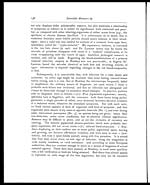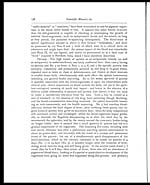Medicine - Institutions > Army health reports and medical documents > Scientific memoirs by medical officers of the Army of India > Part III, 1887 > 10 - Note on some aspects and relations of the blood-organisms in ague
(163) Page 157
Download files
Individual page:
Thumbnail gallery: Grid view | List view

Medical Officers of the Army of India.
157
onwards into such (cases 6 and 7). 2. Leucocytes containing outside their
nucleus black pigment-granules, few or several, having been seen in connection
with free organisms and not occurring in other infections, constitute, even when
alone, decisive evidence of malarial blood-deterioration: they are late pheno-
mena, and may persist for some days; but they were not always visible, even
concurrently with other evidence, microscopic and clinical.—(c. ) Much larger
pale nucleated cells; ladened with pigment (melanine) in the form of clumps,
extra-nuclear; often large and numerous, colloid rather than crystalline, and
unaccompanied with disintegrating red-discs, were in my experience rare yet
quite characteristic (cases 6 and 7): concurring with free and sessile organisms,
some persisting longer and a few for a day or two alone: they are derived from
the splenic pulp and endothelium. (d. ) Pigment in free state; black, brown
or blue in tint, having been found in the blood as late and final stage of verit-
able infection, bears a certain valid significance: such particles very scantily and
alone seen in a few malarious cases under List A above, were not, however,
regarded as proof enough.
Prognostic import. —The natural, unopposed course of the malarial infec-
tion seems highly varied; being acute, sub-acute, or chronic, and either early
fatal or under certain conditions spontaneously subsiding. Owing to the bene-
ficial action of an accessible remedy—quinine,—prognosis becomes more favour-
able the clearer the diagnosis. With one exception, the visible blood-states
have not proved of particular prognostic value: thus, in case 5 organisms
flourished in the blood without any concomitant fever or even discomfort; and
No. 3 showed their disappearance temporarily during the occurrence of smart
intercurrent pyrexia; the incompatibility of blood-parasite and pyrexia being
also indicated in No. 1, which displayed abundant spherules in the cold stage,
and fewer and disintegrated organisms as the acme of fever was approached
and passed; leaving no trace during apyretic intervals, except once, on date
of a periodic suppressed relapse. The flagellated bodies were never present
along with pyrexia: it has been said that they precede febrile onset (Laveran);
yet after quinine at Bombay they were rather terminal phenomena.1Case No. 2
showed, repeatedly, smart fever (t. 102-3° F.), with many crescentic organs,
in the blood, and no suffering (quinine not yet given); so that probably febrile
reaction is really a contingent event. As regards the pigmented intra-disc forms,
it was proved by Nos. 6 and 7 that a considerable number of red copuscles may
be undergoing invasion and disintegration, at a post-febrile period (quinine
given) while convalescence is steadily progressing; and this datum I regard as
important. To what extent malarial fever is self-limited, has yet to be ascer-
tained, see the next heading; several cases of prolonged fever here, known as
1Tertian ague ending spontaneously has lately displayed many flagellate organisms for several days,
beginning with the third after cessation of fever: so that the influence of quinine is not essential to this re-
markable phenomena.
X 2
Set display mode to: Large image | Zoom image | Transcription
Images and transcriptions on this page, including medium image downloads, may be used under the Creative Commons Attribution 4.0 International Licence unless otherwise stated. ![]()
| Permanent URL | https://digital.nls.uk/75004495 |
|---|
| Shelfmark | IP/QB.10 |
|---|---|
| Additional NLS resources: | |




